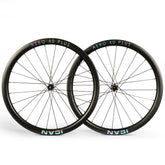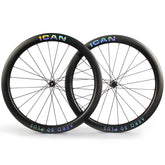How do you choose your mountain bike cranks?
The crank is one of the most important and functional parts of a mountain bike . Without it, your bike is useless. It is the only part that connects you to the frame via the pedals and to the rear wheel via a chain. A crank can make or break your cycling enjoyment. A smooth-running crank allows for better power transfer and ensures smooth operation of your bike.
If you're looking for a new crankset, you can find a decent pair for well under $100, or even pay up to $1000 for the highest quality pair you can find. Why are these high-quality cranks so expensive? To put it simply: it's the weight, or more precisely the lack of weight. As with so many bike parts, the more you spend, the lighter it gets. While weight is the main reason, there are also other benefits of these more expensive products, such as rigidity and durability, which we will explore in more detail in this article. First you can watch the video.
Do I need 1x or 2x?
In the early days, bicycles had a single front chainring and only a rear sprocket for changing gears. The bicycle industry increasingly developed and innovated by equipping racing bikes with double and even triple chainrings, allowing for a wider range of gear ratios. Mountain bikes quickly adapted to the same system and added even more sprockets at the rear to further increase the gear range.
In recent years, the 1x drive system has become the industry standard. This means that you will only find one chainring on your crankset. Because of its simplicity, this system is very popular. A front derailleur adds weight, cost, maintenance, and complexity to multiple chainring shifting.
In addition, the rear sprockets have become larger and the cassettes are offered with a gear ratio of 10 to 52 teeth. The larger gear ratio makes double and triple chainrings almost unnecessary. Although some riders still swear by a double chainring, a single chainring is perfect if the rear sprocket range is enough to handle all local climbs and descents.

Gear ratios and chainrings
We have already mentioned the term gear ratio. If I were to explain it, I would say this: Gear ratio determines how hard you work to turn your wheels. The gear ratio is determined by comparing the number of teeth on the front chainring to the number of teeth on the rear sprocket. For some of us this is very confusing as the term "higher gearing" refers to both the larger front chainring and the smaller rear sprockets. A lower gear, on the other hand, refers to a smaller front chainring and a larger rear sprocket. A higher gear ratio produces more power and speed, making it ideal for downhill and flat routes. A lower gear ratio produces less power but also uses less energy, making it ideal for difficult climbs. When choosing a crankset, you should compare the different chainring sizes available with your rear sprocket and the clearance in the bottom bracket area. The most common chainring sizes are 30, 32, 34 or even up to 36 teeth.
Additionally, you should check whether the crank arm is compatible with the chainring model and brand you want. The most important consideration is how the chainring attaches to the crank. Some brands use a proprietary direct mount system, or BCD (Bolt Circle Diameter). Each modern 1x chainring uses an alternating narrow and wide tooth profile to improve chain grip.
How long should my MTB cranks be?
There are a few sizing details to consider when looking for the best mountain bike crankset. First, there is the length of the crank arm. The three main crank lengths are 165mm, 170mm and 175mm. Traditional logic dictated that longer cranks work better with longer legs, which is why 175mm was often used on larger bikes. Remember that the length of the crank arm can affect your riding style and the fit of your bike. However, most of the time riders just ride what comes pre-installed on their bike.
However, it would be helpful if you keep in mind that with longer crank arms there is a risk of hitting rocks and debris with your pedal or crank arm. These days clearance is everything, and 170mm is popular for increasing the distance between the ground and the crank tips at the bottom of the pedal revolution and reducing shock on uneven trails. Although stepping on the pedal can result in an accident, it rarely damages the part to the point where it becomes unusable. When looking for a new crankset, you need to consider the type of bike you ride. On an XC bike, the bottom bracket is placed higher than on an enduro bike.
Which bottom bracket do I need?
When installing new cranks, check which bottom bracket design you need. Most crank manufacturers use the size of their bottom bracket. So if you switch to a different brand, you will need to replace your bottom bracket. Conversely, there are also some standards used by frame manufacturers that limit the use of bottom brackets and therefore the choice of mountain bike cranks.
The best way to figure out which cranks to choose is to find out which ones are currently mounted on your bike. The easiest way is to check your frame manufacturer's specifications. If you don't have any cycling knowledge, ask your local bike shop for advice. In most cases you will have either a 24mm or 30mm diameter axle. Some brands, like SRAM's DUB system, use a proprietary axle diameter (28.99mm for SRAM), which requires a bottom bracket from SRAM's DUB ecosystem. But for most regular cranks you can choose any third party bottom bracket as long as you have the right axle diameter.
construction
Cranks are forged from one of these three materials – aluminum, carbon and titanium. Each has its different advantages and disadvantages. The cheapest cranks are made of aluminum; They are also the heaviest and slightly more flexible. The top of the Bill alloy cranks are forged to align the grain structure of the aluminum and are not machined. Some brands also use sophisticated forged hollow arms to save weight. Carbon bicycle cranks are the next step; They are much stiffer and have a significant weight saving compared to their aluminum counterparts. The added stiffness is intended to improve power transfer and reduce flex to increase responsiveness when riding the bike with your feet through corners and features. Finally, titanium cranks, which are extremely strong and efficient, are a top-notch upgrade. Although most riders probably wouldn't feel the difference compared to a top alloy crank. Titanium's biggest advantage is its durable construction. But as with all premium products, the price is extremely high.
When choosing a new crank, consider the discipline you will most likely be riding. If you ride a lot of XC, a lightweight carbon crank is your best choice. You get the lightest component possible and get the maximum performance out of it.
For a more downhill riding style, an aluminum crank might be a better option. In the event of a stone chip, the risk of the crank breaking is lower than with a carbon crankset.





